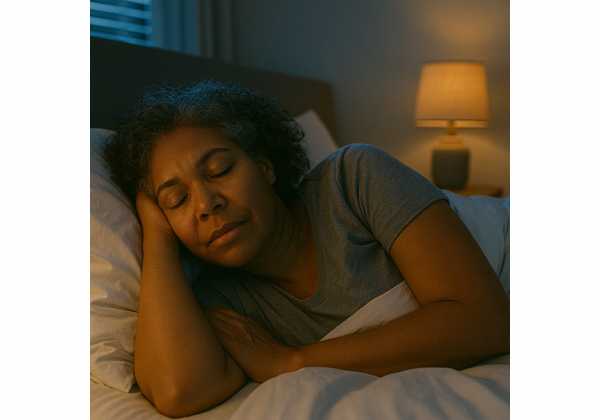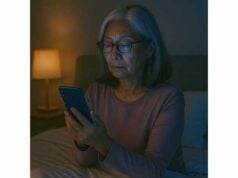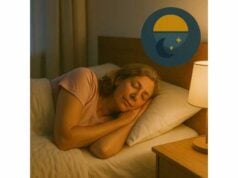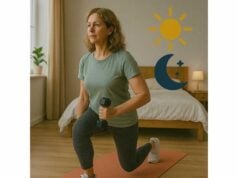
Sleep that is deep, continuous, and predictable is one of the most powerful levers for healthy aging. Yet the basics—light at the right times, a quiet and cool bedroom, and an evening routine that actually winds you down—often get drowned out by gadgets and hacks. This guide distills what works into plain steps. You will learn how to control light exposure across the day, set up a bedroom that protects slow-wave and REM sleep, fine-tune temperature and bedding (including night sweats solutions), design a pre-sleep routine you can repeat, draw tech boundaries that stick, and reinforce everything with morning anchors. For a broader view of how sleep fits with stress and recovery for long-term health, see our concise overview of sleep, stress, and recovery strategies. Use this article as a checklist you can test this week—no fads, just practical changes that improve tonight’s sleep and tomorrow’s clarity.
Table of Contents
- Light Exposure Control: Morning Bright and Evening Dim
- Bedroom Setup: Darkness, Noise Masking, and Air Quality
- Temperature, Bedding, and Night Sweats Management
- Pre Sleep Routine: Screens, Stretching, and Wind Down
- Tech Boundaries: Notifications, Do Not Disturb, and Charging
- Morning Anchors: Consistent Wake Time and Outdoor Light
- Creating a Weekly Checklist You Can Stick To
Light Exposure Control: Morning Bright and Evening Dim
Light is the master switch for your circadian rhythm. Morning brightness starts the daily timer that regulates hormones, body temperature, and alertness; evening dimness protects melatonin and sets the stage for deep, consolidated sleep. Treat light like a prescription: right dose, right timing.
Morning bright (anchor your clock):
- Get outside within an hour of waking. Aim for 5–30 minutes depending on season and cloud cover. Outdoor light delivers thousands of lux even on overcast days, far outpacing indoor bulbs.
- If you rise before dawn or in winter at high latitudes, use a bright, broad-spectrum light near eye level for 20–30 minutes. Keep it in your morning zone—never at night.
- Pair light with gentle movement (a short walk or light chores). The combination accelerates temperature rise and clears residual sleep inertia.
Daylight through the day (sustain alertness):
- Work near a window or add more ambient light during your most focused hours. Brief outdoor “light snacks” (2–5 minutes) each hour help many people maintain energy without extra caffeine.
- Dim the workstation in the last two hours before bed: shift to warm color temperatures and lower intensity.
Evening dim (protect melatonin):
- Two hours before bed, swap overhead lights for low, indirect lamps. Use warm bulbs and minimize screen brightness. If you need to view a screen, enable the strictest night settings and reduce contrast.
- Keep the bedroom very dark. Even small amounts of light can fragment sleep; aim for darkness you cannot navigate in without a light source.
- If you wake at night, avoid ceiling lights. Use a small, low-mounted night light (warm tone) to maintain safety without blasting your eyes.
Practical guardrails:
- Shift stimulating screen tasks earlier. If a late session is unavoidable, cap it at 20–30 minutes, reduce brightness, and avoid fast-cut video or work that spikes heart rate.
- Treat the last hour as a “light diet.” Reading on paper, quiet conversation, breathwork, or a warm shower (timed right; more below) support the brain’s transition.
Remember: timing beats perfection. Big wins come from consistent morning exposure and reliably dim evenings, not from chasing gadget settings. If you want a deep dive on screen hygiene and evening light filters that actually matter, see our focused tips on reducing evening light load.
Bedroom Setup: Darkness, Noise Masking, and Air Quality
Your bedroom should make good sleep the default. Three elements matter most: darkness, sound control, and clean, comfortable air. Think of this space as a sensory-reduced zone where nothing fights your brain’s drive to sleep.
Darkness:
- Blackout the windows. Use true blackout shades or layered curtains; light leaks around edges are common, so add side tracks or draft stoppers if needed.
- Remove status LEDs. Tape over indicators on chargers and electronics. If you need a clock, choose a dim, amber display or turn it away from the bed.
- Eye masks help, especially if you cannot fully control window light or share a room with a partner on a different schedule. Look for a mask that does not press on eyelids and has a contoured nose bridge.
Noise control:
- Nighttime noise wakes you more when it is intermittent and unpredictable. Aim to flatten peaks rather than chase absolute silence.
- Mask the spikes: a steady broadband sound (fan, white/pink/brown-noise device) covers sudden door slams or traffic. Volume should be just high enough to blur peaks without being intrusive.
- Reduce sources: oil squeaky hinges, place felt pads under doors, and ask housemates to close doors gently after a certain hour. In urban settings, a draft stopper at the door bottom cuts hallway noise.
- Earplugs as a backup (silicone or foam) can be useful, but test comfort. If safety alerts are a concern, route critical notifications to a smartwatch with a gentle vibration (and silence the rest; see tech boundaries below).
Air quality and comfort:
- Cool, slightly drier air helps limit awakenings. Target a room temperature in the 16–19 °C range and relative humidity around 40–50%.
- Ventilate daily. A five-minute window open during the day can reduce stale air and odors without chilling the room at night.
- Filter wisely. If you live with wildfire smoke, dust, or allergies, a HEPA purifier reduces particulates that irritate nasal passages and trigger mouth breathing or snoring.
- Bedding hygiene: Wash pillowcases weekly and sheets every one to two weeks. If dust mites bother you, use allergy covers for pillows and mattress.
Layout and flow:
- Keep the bed for sleep and intimacy—nothing else. No desk tucked into a corner, no stack of work folders in view. Visual clutter raises nighttime arousal.
- Route cords and chargers out of line of sight. A clean surface calms the mind.
Not sure which changes will matter most? Try a two-week A/B test: first week with blackout only; second week with blackout plus sound masking. Track awakenings and next-day alertness. Keep what moves the needle. If you use devices to track trends and want a sane plan for what to ignore, these practical pointers on useful sleep metrics can help.
Temperature, Bedding, and Night Sweats Management
Falling asleep requires a drop in core body temperature of roughly 1 °C. Staying asleep depends on keeping skin temperature comfortable and stable. Heat spikes—whether from a warm room, dense bedding, hot flashes, or night sweats—trigger awakenings. Good sleep hygiene makes temperature an ally.
Room and body temperature:
- Room: Aim for 16–19 °C. If you prefer a warmer room, compensate with a lighter duvet and breathable layers.
- Pre-sleep warming: A warm (not hot) shower or bath 60–90 minutes before lights out promotes peripheral vasodilation so core temperature falls after you dry off, easing sleep onset.
- Evening exercise: Vigorous sessions close to bedtime can delay cooling. If late workouts are your only option, finish at least two hours before bed and include a slow cool-down.
Bedding strategy:
- Layering beats bulk. Use two lighter blankets rather than a single heavy duvet so you can adjust without fully waking.
- Fabrics: Choose breathable weaves (percale cotton, linen, or performance blends). Avoid heat-trapping foams without cooling channels; add a breathable mattress protector if needed.
- Separate microclimates: If one partner sleeps hot and the other cold, split bedding (two twin duvets on a king) or use a dual-zone topper or pad.
Night sweats and hot flashes:
- Plan for quick changes. Keep a spare top and a small towel or liner at the bedside to swap layers without bright light.
- Moisture-wicking layers (light base layer under pajamas) reduce clammy awakenings.
- Alcohol timing: Even one or two drinks within three hours of bed can produce early-night heat spikes and REM suppression—especially in midlife.
- Hydration: A small glass of water at the bedside can help after a sweat episode; avoid large volumes late to reduce nocturia.
Airflow and humidity:
- Gentle circulation (quiet ceiling or floor fan) keeps skin temperature even. In humid climates, a dehumidifier prevents sticky awakenings; in dry winters, a small humidifier can prevent nasal dryness that forces mouth breathing.
When hormones drive heat:
- During menopause and andropause, fluctuating sex steroids can destabilize temperature regulation and raise nighttime arousals. Behavioral strategies still help, but persistent symptoms deserve clinical options (from nonhormonal agents to hormone therapy where appropriate). For a clear overview of sleep-focused adjustments during midlife transitions, see practical guidance on hormone-related sleep strategies.
Self-test protocol (two weeks):
- Set the thermostat or bedroom target to 18 °C.
- Take a warm shower 60–90 minutes pre-bed for at least seven nights.
- Layer breathable bedding and add gentle airflow.
Track sleep latency, awakenings, and next-day energy. Keep what clearly helps and discard the rest.
Pre Sleep Routine: Screens, Stretching, and Wind Down
The last 60–90 minutes set the tone for the night. A good wind-down reduces cognitive and physiological arousal, shields you from light that disrupts melatonin, and prepares your body to cool. The trick is to make it repeatable, not perfect.
Design a simple sequence (30–60 minutes):
- Step 1 — Shut down inputs: Finish email, messages, and logistics. Write tomorrow’s top three tasks on paper. This offloads loops that would otherwise spin at 2 a.m.
- Step 2 — Dim and warm your light: Switch to low, indirect lamps. Consider a single warm bulb at desk height if you like to read.
- Step 3 — Gentle body cues: A 5–10 minute stretch flow (calves, hamstrings, hip flexors, thoracic spine) or a short restorative yoga routine eases muscle tension from the day. Avoid max holds or anything that spikes heart rate.
- Step 4 — Breathwork or quiet focus: Try 4-7-8 breathing, box breathing (4-4-4-4), or a 5-minute body scan. These practices lower sympathetic tone and ease the transition to sleep.
- Step 5 — Hygiene, then bed: Keep bathroom lighting low. If you shower in the evening, time it 60–90 minutes before lights out.
Screens without sabotage:
- If you must use a device, set it to the lowest brightness, enable strict night mode, and keep content calm (no doom-scrolling or high-contrast action). Prefer audio or paper.
- Cap screen time in the last hour. If the evening is your only time for reading on an e-reader, choose a model with an amber front-light and lowest usable intensity.
Food and drink:
- Finish dinner 3–4 hours before bed; heavy, spicy, or high-fat meals later in the evening fuel reflux and awakenings.
- Limit alcohol in the second half of the day, and avoid it within three hours of bedtime.
- If you get hungry near lights out, try a small, balanced snack (for example, Greek yogurt with berries or a glass of milk) and test whether it helps or hurts your sleep continuity.
Caffeine and supplements:
- Set a personal caffeine curfew; many midlife adults need a noon cutoff. If you are sensitive, move it to 10 a.m.
- Some people find magnesium glycinate (100–200 mg elemental), glycine (3 g), or L-theanine (100–200 mg) helpful. Treat them as adjuncts, not substitutes for behavior and light control.
If evening screens remain your weak spot, this short guide to screen and lighting habits shows how to lower light dose—and arousal—without giving up your routine.
Tech Boundaries: Notifications, Do Not Disturb, and Charging
Phones and wearables can support sleep, but unmanaged notifications and blue-white light leak arousal into the hours designed for recovery. Set firm boundaries so technology works for you, not against you.
Silence the night by default:
- Enable Do Not Disturb from a fixed time (for example, 21:00 to after your wake time). Allow calls from favorites only and repeat-call exceptions for emergencies.
- Turn off lock-screen previews for messages and email after your DND start time. Glimpsed subject lines reignite work mode.
- Route truly urgent alerts (elder care devices, home security) to a single channel—ideally a gentle watch vibration—so you can mute everything else.
Physical separation:
- Charge devices outside the bedroom. If that is not possible, place the phone across the room, face down, and cover LEDs. Use a simple alarm with an amber display.
- Consider a “drop zone”: at your DND start, deposit phone and laptop there, then begin your wind-down sequence.
Screen settings that stick:
- Keep the most distracting apps off your home screen or in a folder you never open at night.
- Disable autoplay and infinite scroll for video apps during evening hours if your device allows schedule-based limits.
- Use grayscale after your DND start time. The less visually rewarding the screen, the less likely you are to slip into late-night scrolling.
Wearables:
- If you like sleep-stage graphs, check them after your morning routine—not at 2 a.m. Avoid making middle-of-the-night decisions based on device estimates.
- Focus on trends (time asleep, consistency, awakenings), not single-night swings.
Tech-supported calm:
- Replace scrolling with a guided breathing track or short meditation. Keep the device face down with brightness at minimum.
- Use a bedtime playlist or audiobook with a 20–30 minute sleep timer—audio can soften rumination without bright light.
Better boundaries lift heart-rate variability and reduce “mental wakefulness” at bedtime. If you want to connect objective recovery signals with your nighttime routine, this primer on interpreting HRV for recovery explains how to use trends without getting obsessive.
Morning Anchors: Consistent Wake Time and Outdoor Light
Great nights are built in the morning. A stable wake time and early outdoor light tell your circadian system when the day begins. Over a week, these anchors reduce social jet lag, increase daytime energy, and make bedtime feel natural rather than forced.
Wake time as the keystone:
- Choose the earliest wake time you can sustain seven days a week. Protecting this anchor tames weekday-weekend swings that otherwise feel like flying across time zones every Friday and Sunday.
- After a short night, resist sleeping in. Instead, hold your wake time and use a 10–20 minute early-afternoon nap to bridge the day.
Morning light routine (10–30 minutes):
- Step outside soon after waking—on a balcony, porch, or short walk. Outdoor light intensities dwarf indoor bulbs, even on gray days. If you cannot go out, raise blinds and sit near a window.
- Combine light with movement. A short walk or simple chores amplify alertness and speed temperature rise.
- Save bright artificial lights for dark mornings only; avoid using them after late afternoon.
Hydration and first calories:
- Drink water upon waking. If you tolerate breakfast, include protein (20–30 g) to steady energy and discourage late-night snacking.
- Time caffeine to your schedule. Many people feel better delaying the first cup 60–90 minutes, especially if they wake early; others do better with a small cup right away. Test and track.
Routine that resists drift:
- Pin two or three quick habits after wake time: make the bed, open blinds, step outside. The chain keeps you off your phone and into the day.
- Keep morning workouts consistent where possible. If evenings are busy, a regular morning walk is better than sporadic late-night training.
Travel and shift weeks:
- On trips, set your watch to local time on the plane and start anchors on arrival day: light exposure and a modest walk. Strategic short naps can help, but keep them early and brief.
- For shift transitions, maintain a fixed anchor sleep block and add planned naps to meet total sleep needs.
For more ways to strengthen circadian signals—especially the interplay of morning light and evening darkness—see practical tactics in simple circadian wins you can implement in a day.
Creating a Weekly Checklist You Can Stick To
Consistency beats intensity. A weekly checklist turns sleep hygiene into autopilot and frees you from willpower battles at midnight. Build yours around light, environment, temperature, routine, and tech boundaries—then track two or three outcomes so you know it is working.
Your core checklist (edit to fit your life):
- Daily light plan
- Morning: 10–30 minutes outdoors within an hour of waking.
- Evening: dim lights two hours before bed; no overheads in the final hour.
- Bedroom
- Blackout shades closed; status LEDs covered.
- Sound masking on; volume just enough to blur peaks.
- HEPA purifier on if allergies or smoke are issues.
- Temperature and bedding
- Thermostat set to 16–19 °C.
- Warm shower 60–90 minutes before bed on most nights.
- Breathable layers; spare top ready if prone to night sweats.
- Pre-sleep routine (30–60 minutes)
- Write tomorrow’s top three tasks.
- 5–10 minutes stretching plus a short breathing practice.
- Low, warm light; paper reading or audio.
- Tech boundaries
- Do Not Disturb from 21:00 to wake time.
- Devices charge outside the bedroom or across the room, face down.
- Grayscale and strict night mode after DND start.
- Morning anchors
- Fixed wake time seven days a week (±60 minutes).
- Light plus movement within an hour of waking.
Track what matters (weekly view):
- Total sleep time (weekly average) and sleep efficiency (asleep ÷ in bed).
- Awakenings you remember (≥2 minutes).
- Afternoon sleepiness (1–9 scale) and mood (three-item check).
- Optional: reaction time with a simple phone app once or twice weekly.
Run two-week experiments:
- Change one variable (for example, move dinner earlier by 60 minutes or add nightly warm showers).
- Hold all else steady.
- Compare to the prior two weeks on awakenings, afternoon energy, and reaction time. Keep the winner.
Motivation and setbacks:
- Expect off nights. Stay on schedule the next morning and use a short early-afternoon nap if needed.
- Share your plan with a partner or roommate so the household supports lights-down and noise control.
- Revisit the checklist each season—light patterns, humidity, and temperatures change.
Red flags to escalate:
- Loud snoring, witnessed pauses, choking, or morning headaches.
- Persistent insomnia (≥3 nights/week for ≥3 months) despite a clean routine.
- Daytime sleepiness that risks safety.
In these cases, pair environment and routine changes with medical evaluation. Your checklist will make any treatment easier to adopt and sustain.
References
- Behavioral and psychological treatments for chronic insomnia disorder in adults: an American Academy of Sleep Medicine clinical practice guideline (2021) (Guideline)
- Evening use of light-emitting eReaders negatively affects sleep, circadian timing, and next-morning alertness (2015) (Experimental Study)
- Environmental Noise Guidelines for the European Region (2018) (Guideline)
- Before-bedtime passive body heating by warm shower or bath to improve sleep: A systematic review and meta-analysis (2019) (Systematic Review and Meta-analysis)
- High Sensitivity of Melatonin Suppression Response to Evening Light in Preschool-Aged Children (2022) (Experimental Study)
Disclaimer
The information in this article is educational and is not a substitute for personalized medical advice, diagnosis, or treatment. Speak with your physician or a qualified sleep specialist about symptoms, testing, medications, or supplements—especially if you have persistent insomnia, suspected sleep apnea, heavy snoring, or night sweats that disrupt sleep.
If you found this guide useful, please consider sharing it with a friend or on Facebook or X, and follow us for future updates. Your support helps us continue creating practical, evidence-informed resources for healthy aging.










